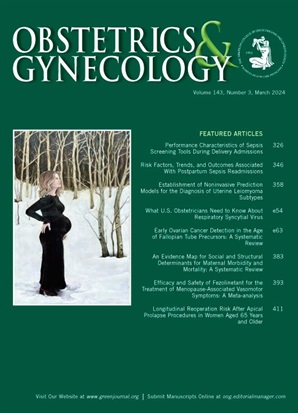Molecular Characterization and Clinical Implications of Endometrial Cancer.
IF 4.7
2区 医学
Q1 OBSTETRICS & GYNECOLOGY
引用次数: 0
Abstract
The classification of endometrial cancer (EC) has diverged from traditional histologic features based on microscopic appearance to objective molecular characterization. Molecular characterization of EC is pivotal to inform prognosis and to guide therapeutic recommendations. First described by the Cancer Genome Atlas, molecular profiling was later revised by the Proactive Molecular Risk Classifier for Endometrial Cancer and TransPORTEC algorithms to create clinically applicable and relatively easy-to-implement molecular classification systems. Since 2020, the World Health Organization recommended molecular classification of EC into four distinct prognostic subtypes: ECs with polymerase ε (POLE) pathogenic mutations assessed by gene sequencing, mismatch repair deficiency determined by immunohistochemistry or microsatellite instability assay, and p53 abnormalities determined by immunohistochemistry or next-generation sequencing. The final molecular subtype without any of these defining features is called "no specific molecular profile" (NSMP). This is further stratified by estrogen receptor (ER) immunohistochemistry status. Patients with cancers identified as POLE pathogenic mutations have the best prognosis with almost no recurrence or death events, followed by those with strong ER-positive NSMP cancers. Mismatch repair deficiency ECs have intermediate prognosis, whereas p53 abnormalities and ER-negative NSMP have the worst prognosis. Other molecular and pathologic biomarkers of interest include tumor mutational burden, human epidermal growth factor receptor 2, L1 cell adhesion molecule, β-catenin (CTNNB1), and lymph vascular space invasion, which may have prognostic and predictive implications. The current guidelines will continue to evolve; however, at minimum, it is recommended that all patients undergo testing for mismatch repair, p53, and ER, and POLE testing may be prioritized in select circumstances. Molecular classification provides the critical framework to deliver effective, personalized, high-quality care and informs clinical trial design. Molecular assessment ensures consistent diagnosis and provides prognostic information and predictive data to guide appropriate management.子宫内膜癌的分子特征及临床意义。
子宫内膜癌(EC)的分类已经从传统的基于显微外观的组织学特征转向客观的分子特征。EC的分子特征是告知预后和指导治疗建议的关键。首先由癌症基因组图谱描述,分子谱分析后来被子宫内膜癌的前瞻性分子风险分类器和TransPORTEC算法修订,以创建临床适用且相对易于实施的分子分类系统。自2020年以来,世界卫生组织推荐将EC分子分类为四种不同的预后亚型:通过基因测序评估具有聚合酶ε (POLE)致病性突变的EC,通过免疫组织化学或微卫星不稳定性测定确定错配修复缺陷,以及通过免疫组织化学或下一代测序确定p53异常。没有任何这些定义特征的最后一种分子亚型被称为“无特定分子谱”(NSMP)。根据雌激素受体(ER)免疫组织化学状态进一步分层。确定为POLE致病性突变的癌症患者预后最好,几乎没有复发或死亡事件,其次是强er阳性的NSMP癌症患者。错配修复缺陷的ECs预后中等,而p53异常和er阴性的NSMP预后最差。其他感兴趣的分子和病理生物标志物包括肿瘤突变负荷、人表皮生长因子受体2、L1细胞粘附分子、β-连环蛋白(CTNNB1)和淋巴血管间隙侵袭,这些可能具有预后和预测意义。目前的准则将继续发展;然而,至少建议所有患者接受错配修复、p53和ER检测,在特定情况下,可以优先进行POLE检测。分子分类提供了提供有效、个性化、高质量护理的关键框架,并为临床试验设计提供信息。分子评估确保一致的诊断,并提供预后信息和预测数据,以指导适当的管理。
本文章由计算机程序翻译,如有差异,请以英文原文为准。
求助全文
约1分钟内获得全文
求助全文
来源期刊

Obstetrics and gynecology
医学-妇产科学
CiteScore
11.10
自引率
4.20%
发文量
867
审稿时长
1 months
期刊介绍:
"Obstetrics & Gynecology," affectionately known as "The Green Journal," is the official publication of the American College of Obstetricians and Gynecologists (ACOG). Since its inception in 1953, the journal has been dedicated to advancing the clinical practice of obstetrics and gynecology, as well as related fields. The journal's mission is to promote excellence in these areas by publishing a diverse range of articles that cover translational and clinical topics.
"Obstetrics & Gynecology" provides a platform for the dissemination of evidence-based research, clinical guidelines, and expert opinions that are essential for the continuous improvement of women's health care. The journal's content is designed to inform and educate obstetricians, gynecologists, and other healthcare professionals, ensuring that they stay abreast of the latest developments and best practices in their field.
 求助内容:
求助内容: 应助结果提醒方式:
应助结果提醒方式:


